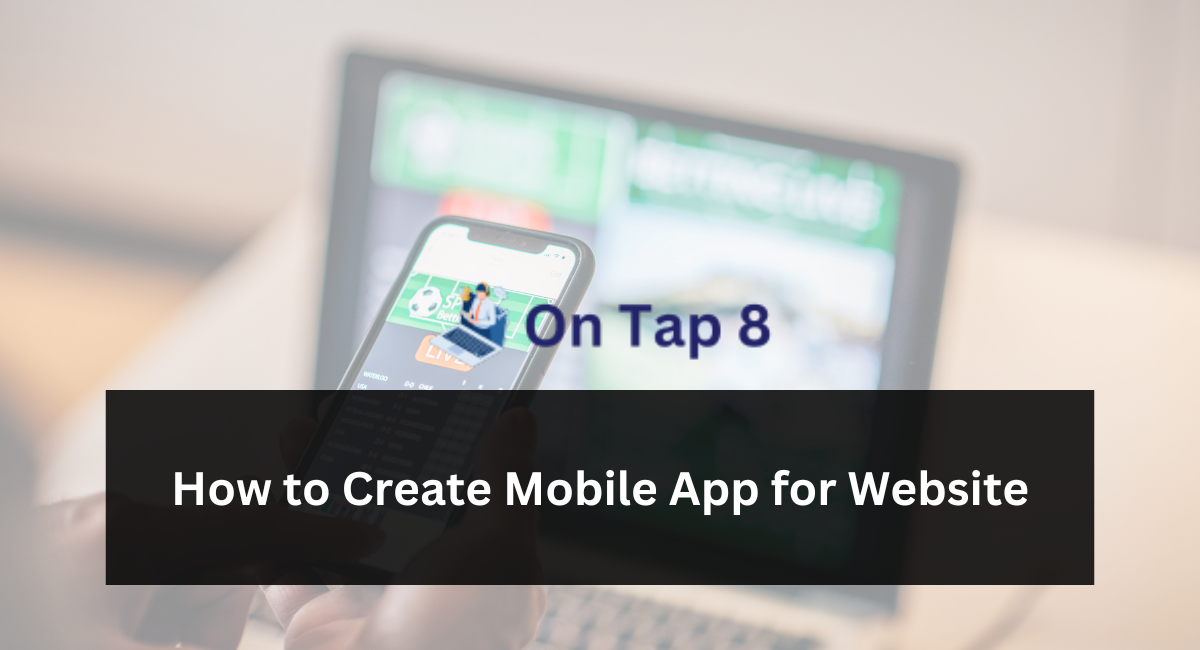In the present era of technology, having a mobile application for your website can significantly improve user experience and broaden your reach to a larger audience.
Mobile applications provide convenience, easy access, and personalized interactions that can attract and maintain users. If you’re thinking of creating a mobile app for your website but are unsure of how to begin, you’re in the correct location.
In this guide suitable for beginners, we will lead you through the process of developing a mobile app for your website. We will provide you with detailed instructions and useful information to assist you in realizing your vision.
Recognizing the Significance of Mobile Applications:
Mobile applications have become a crucial aspect of daily existence, with countless individuals throughout the globe depending on them for various purposes such as communication, entertainment, productivity, and beyond. For website proprietors, having a mobile application provides various advantages:
Improved User Experience:
Mobile applications offer a more engaging and easy-to-use experience in comparison to mobile webpages. With built-in functions like push notifications, offline access, and gesture-based navigation, apps provide a smooth and customized experience for consumers.
Enhanced User Interaction and Retention:
Mobile applications provide greater interaction with users through functionalities like as in-app messaging, gamification, and loyalty programs. By providing useful information and engaging activities, apps can encourage users to return regularly.
Access to Device Features:
In contrast to mobile websites, which are restricted to web browser capability, mobile apps can utilize device features such as camera, GPS, accelerometer, and other capabilities. This creates possibilities for creative features and functions that improve the overall user experience.
Brand Exposure and Awareness:
Being present on users’ mobile devices enhances brand exposure and awareness. An effectively designed and practical app can have a lasting impact on consumers and strengthen your business image.
Guide to Creating a Mobile App for Your Website:
Now, let’s examine the sequential procedure of developing a mobile application for your website:
Specify Your Goals and Target Audience:
Prior to embarking on app development, allocate some time to specify your goals and determine your target audience. Think about what you want to accomplish with your app, whether it’s boosting sales, broadening your audience, or improving user interaction.
Gaining insight into the requirements and inclinations of your audience will steer your approach to app development and assist you in crafting a product that connects with your users.
Selecting the Appropriate Development Approach:
When it comes to constructing a mobile application, you have various development methodologies to consider:
Development of Native Apps:
Native apps are created exclusively for one platform (such as iOS or Android) using languages and tools specific to that platform (Swift or Objective-C for iOS, Java or Kotlin for Android). Native applications provide optimal speed, user experience, and access to device functionalities, but they necessitate separate development for each platform.
Cross-Platform App Development:
Cross-platform frameworks such as React Native, Flutter, and Xamarin enable you to create applications that can be used on several platforms by utilizing a single codebase. Although cross-platform development allows for quicker development and cost savings, it may compromise performance and platform-specific capabilities.
Progressive online Apps (PWAs):
PWAs are online applications that utilize contemporary web technologies to offer a mobile app-like experience on smartphones and tablets. PWAs can be used via a web browser, but they can also be installed on the user’s device.
They include offline access, push notifications, and other capabilities that are similar to those found in native apps.
Select the development option that most closely matches your budget, timetable, and technical needs.
Create Your App Interface:
After selecting a development method, it is time to build your app interface. Take into account the user flow, navigation structure, and graphic design components that will make your app easy to use and visually attractive.
Utilize wireframing and prototyping tools to generate prototypes of your app interfaces and get feedback from stakeholders and potential users.
Create and Test Your App:
Once you have completed the design of your app, it is time to begin the development process. Collaborate with your development team to incorporate the features and functionality described in your app design.
During the development phase, regularly perform testing to discover and resolve any bugs, malfunctions, or usability problems. Testing should involve both functional testing (ensuring that all features perform as intended) and user testing (collecting feedback from actual users to assess the user experience).
Incorporate Analytics and Tracking:
To assess the effectiveness of your app and get understanding of user behavior, incorporate analytics and tracking tools into your app. Monitor important measures including app downloads, user engagement, retention rates, and in-app purchases to track success and guide future improvements of your app.
Send Your App to App Stores:
After your app is created, tested, and refined, it’s time to send it to the appropriate app stores (such as the Apple App Store for iOS apps and Google Play Store for Android apps). Adhere to the app store criteria and submission procedures to ensure a seamless review process. Make sure you have screenshots, app descriptions, and other assets ready for the app store listing.
Market Your Software:
Releasing your software is only the start. To attract users and increase downloads, allocate resources to app promotion and marketing activities.
Utilize your website, social media platforms, email newsletters, and other marketing methods to publicize your app and motivate consumers to download and interact with it. Think of providing benefits like reduced prices, special offers, or unique material to encourage people to download and attract new users.
Advice for Effective Mobile App Development:
In order to guarantee a prosperous process of developing a mobile app, take into account the following suggestions:
Give Priority to User Experience:
User experience should be the main focus of your app development approach. Concentrate on developing a user-friendly interface that is easy to use and brings joy to users, encouraging them to return.
Maximize Performance:
Performance is crucial for mobile applications. Improve your app’s performance, responsiveness, and resource utilization to offer a smooth and uninterrupted experience for users.
Pay attention to user input:
Proactively request input from users during the development process and make changes depending on their comments and preferences. User input is extremely essential for enhancing your app and fulfilling the requirements of your target audience.
Stay Informed about Current Trends:
Stay updated on the most recent trends and technology in mobile app development to make sure that your app stays relevant and competitive in the marketplace. Try out new features, design trends, and emerging platforms to remain ahead of the game.
Conclusion:
Developing a mobile application for your website is a thrilling chance to improve user satisfaction, broaden your audience, and increase your business.
By using the detailed instructions provided in this article and adopting effective techniques for mobile app development, you can turn your app idea into reality and achieve success in the competitive app market.
Make sure to establish your goals, select the appropriate development method, create designs that consider the user, and give importance to performance and quality during the development process.
By being committed, innovative, and focusing on the needs of users, you can develop a mobile application that brings joy to users and boosts business expansion.










